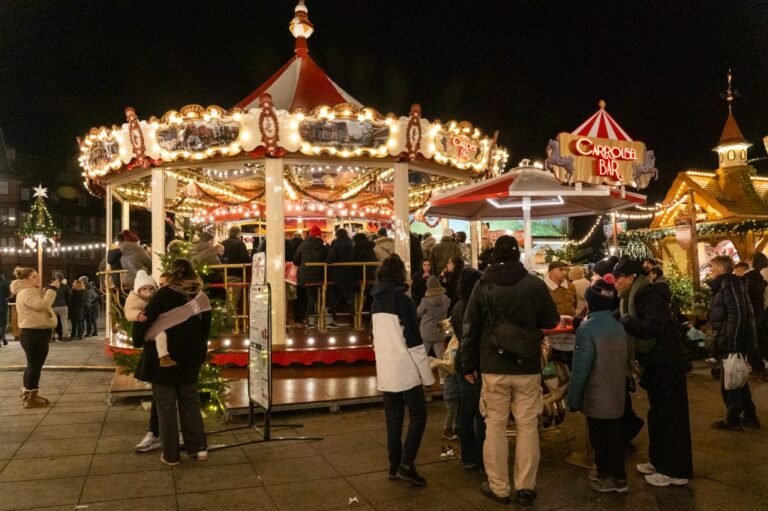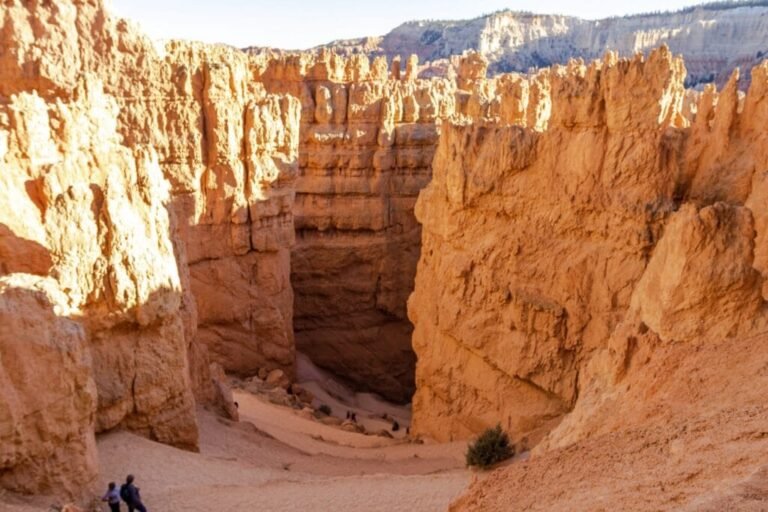
El Camino de Santiago kicked my ass. Well, technically, it kicked my feet. It turns out my minimal preparation for the Camino de Santiago was terrible. After a miserable effort of only four days, the doctor in Legrono told me that I wasn’t allowed to go on until my feet healed. I had walked just over 100 km’s, and my feet were bloodied and blistered.
To be honest, I was relieved.
The thought of putting back on my shoes made me shudder. For the last 9 km, I had stumbled along in jandals and socks. One of the traveling fashion sins I vowed I would never break.
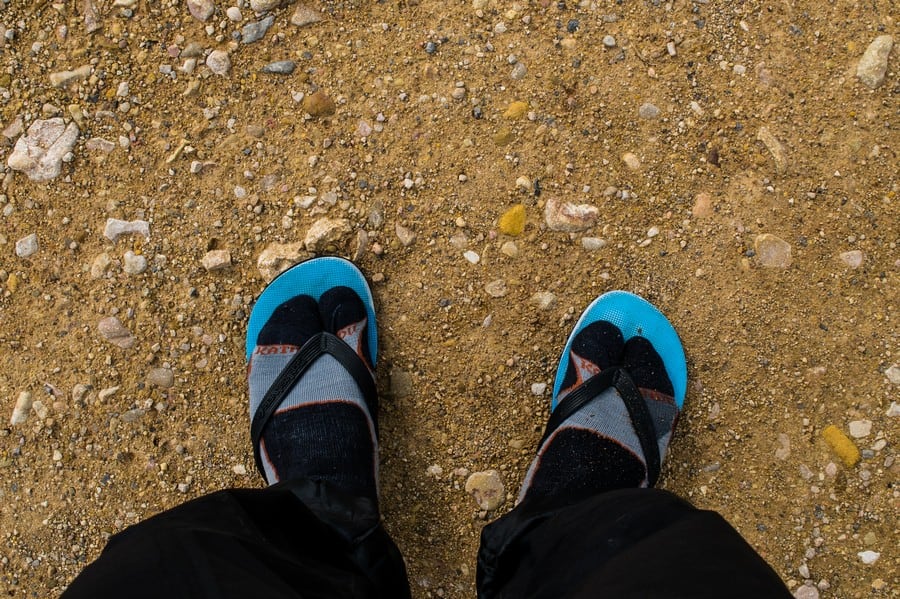
Jandals on the Camino de Santiago
Rediscovering the Beauty of the Camino de Santiago
After being forced to pause my journey, I realized that the Camino de Santiago had left a deeper mark on me than I expected. Though my pilgrimage was cut short, the memories of those first few days were vivid — filled with a mix of exhaustion, gratitude, and wonder. I hadn’t yet reached the more “unsavory” parts that other travelers, like Sherry Ott, mentioned in their accounts. Instead, every step I took was painted with beauty: the golden morning light, the echo of church bells, and the quiet companionship shared with other pilgrims along the road.
Finding Joy in the Unfinished Journey
Even though I didn’t complete the full route, I learned that the Camino de Santiago isn’t just about arriving at Santiago de Compostela. It’s about the stretch of trail that tests your patience, the villages that welcome you, and the small victories — like reaching a hilltop and catching your breath while looking back at how far you’ve come. The unfinished journey became its own story, reminding me that sometimes the Camino gives you exactly what you need, even if it’s not what you planned.
Capturing Moments That Defined My Pilgrimage
Throughout my short time on the Camino de Santiago, I captured hundreds of photos — moments that froze the rhythm of the trail: the sound of gravel underfoot, the smell of wet earth after rain, and the laughter of fellow travelers. These snapshots became my souvenirs, representing both the peace and the pain that come from walking long distances with purpose.
Why the Camino de Santiago Stays With You
The Camino is often described as a pilgrimage that doesn’t end when your feet stop moving. I understand that now. Even after leaving Spain, my thoughts return to the Camino — to the quiet paths, the yellow arrows pointing the way, and the sense of belonging that forms among strangers. My unfinished journey is an open invitation to return, heal, and walk again someday.
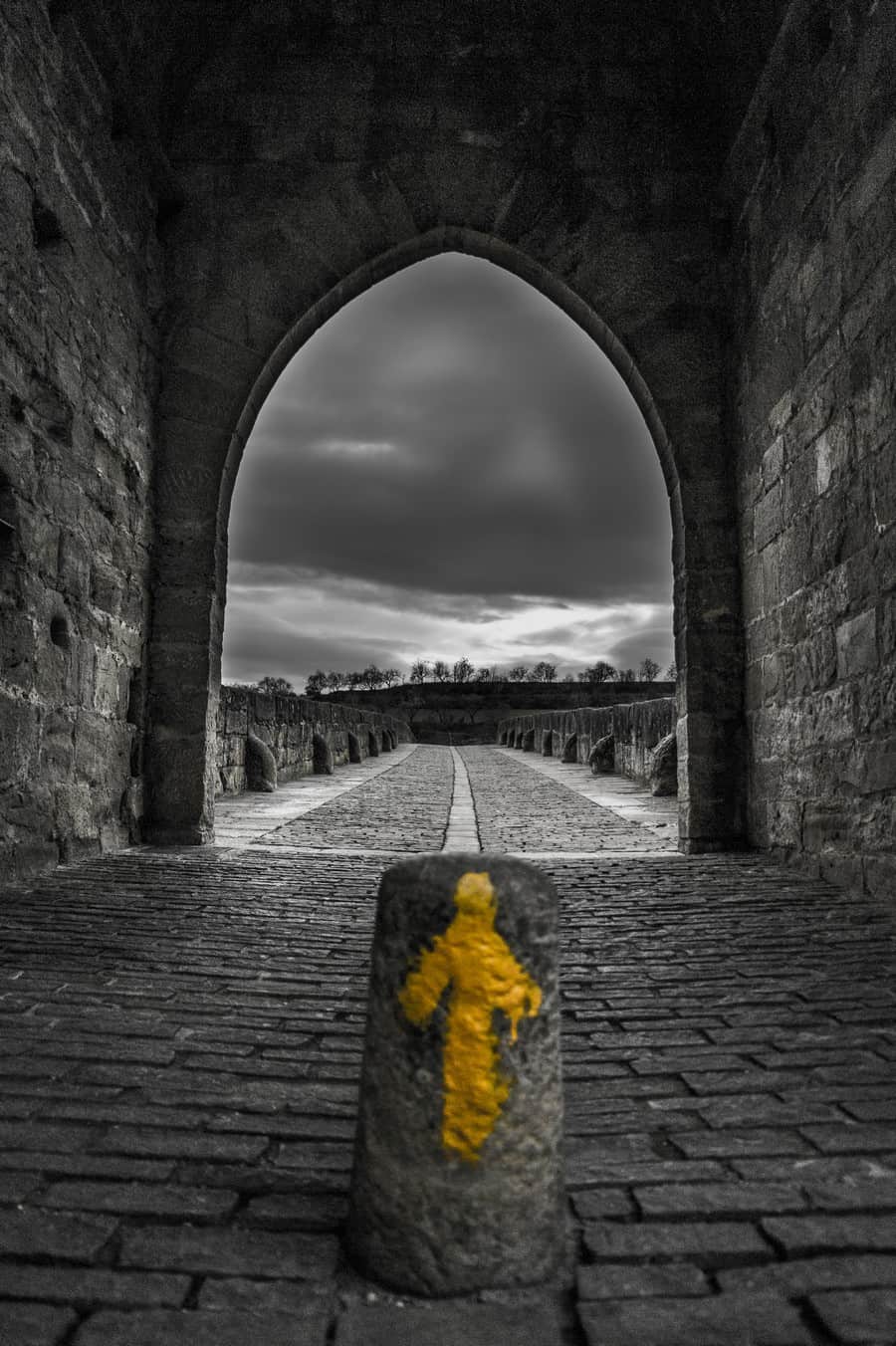
Puenta La Reina Bridge – Camino de Santiago Arrows
Never Lost on the Camino de Santiago: Following the Arrows and Symbols That Guide the Way
One of the most reassuring parts of walking the Camino de Santiago is how impossible it is to truly get lost. From the very first step, the route is marked with yellow arrows, scallop shells, and distinctive signs that guide pilgrims along every bridge, fork, and road crossing. These symbols are the Camino’s lifeline — a quiet language shared by thousands of travelers over the centuries.
The Meaning Behind the Symbols
Each mark along the trail tells a story. The scallop shell, long recognized as the emblem of the Camino de Santiago, represents unity and direction — the grooves of the shell converging to a single point, just like the many paths that lead to Santiago de Compostela. The yellow arrows, painted by volunteers and locals, serve as a modern translation of that ancient guide, pointing pilgrims forward when fatigue or doubt set in.
A Trail Designed for Pilgrims
What makes the Camino de Santiago so unique is how deeply the path is woven into the landscape. Every small village, country road, and cobblestone alley seems to honor the walkers passing through. Whether you’re crossing the Puente La Reina Bridge or wandering through the rolling hills of Navarra, these guiding marks remind you that others have walked the same path — and that you are part of something far bigger than a single journey.
Finding Comfort in Simplicity
There’s a quiet comfort in not needing a GPS or map. Instead, you lift your head, look for the next arrow, and trust the route ahead. That simple act — following a painted mark — becomes a metaphor for the entire Camino de Santiago experience: letting go of control and allowing the journey to unfold, one symbol at a time.

Camino de Santiago Scallop Shell
Climbing Alto del Perdón on the Camino de Santiago: Beauty, Pain, and Perspective
Reaching the top of Alto del Perdón (often called “the Hill of Forgiveness”) was one of the most breathtaking moments of my Camino de Santiago journey. From the summit, I could see both the path I had already conquered — stretching back toward Pamplona — and the road still waiting ahead. It was a rare, humbling perspective: a single view that contained both past effort and future challenge.
The Reward at the Summit
The top of Alto del Perdón is marked by the famous metal pilgrim sculptures, their outlines etched against the open Spanish sky. Standing there, wind pushing against my jacket, I felt the weight of history — thousands of pilgrims who had paused at that very spot before pressing onward. The panorama was endless: rolling hills, winding trails, and distant villages shimmering in the sunlight. For a few minutes, exhaustion disappeared into awe.
The Descent That Tested My Limits
But as any pilgrim learns, what goes up must come down — and the descent from Alto del Perdón is as punishing as it is beautiful. The rocky terrain quickly turned from scenic to brutal. My too-small shoes became my undoing; with each step, my toes slammed into the front, blistering and bruising under the strain. Every stone felt personal, every slip a reminder that the Camino de Santiago demands as much humility as it offers beauty.
Lessons from the Hill of Forgiveness
That stretch taught me more than any postcard-perfect view could. On the Camino de Santiago, even pain carries purpose. The climb reminded me to appreciate the rewards of persistence, while the descent reminded me that preparation — both mental and physical — matters. By the time I reached the bottom, my feet were wrecked, but my spirit was wide open to what the journey still had to teach.

Alto del Pedron Camino de Santiago
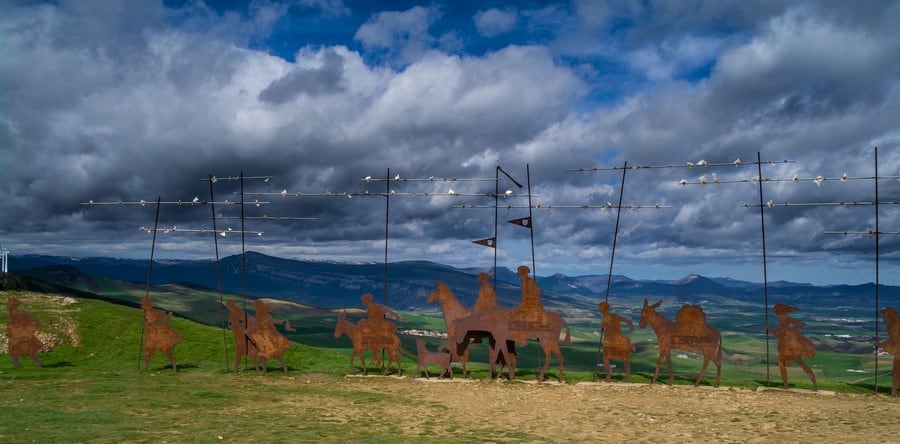
Metal Pilgrims on Alto del Pedron
Exploring the Ancient Churches Along the Camino de Santiago
One of the most unforgettable parts of walking the Camino de Santiago was discovering the many old churches that lined the route. Each village and small town had its own sacred space, often centuries old, standing quietly as a reminder of how deeply faith and tradition are woven into the pilgrimage.
Silent Sanctuaries in Early Spring
Because I walked the Camino de Santiago in early March, many of these churches were still closed, waiting for the busier summer season. Their doors were shut, but the sense of history was unmistakable. The cool morning air carried the sound of distant bells, and even without stepping inside, I could feel the reverence these places held for generations of travelers.
A Connection Across Time
Passing each church felt like walking through a living timeline. Some were simple stone buildings with weathered walls, while others stood tall and ornate, framed by the quiet of empty streets. Even when locked, their presence offered peace. For many pilgrims, including myself, these silent sanctuaries were milestones of reflection and gratitude along the Camino de Santiago.

The Church of Obanos
And between every small village, the well-maintained pathways of the French Way wound across the spectacular Spanish countryside.
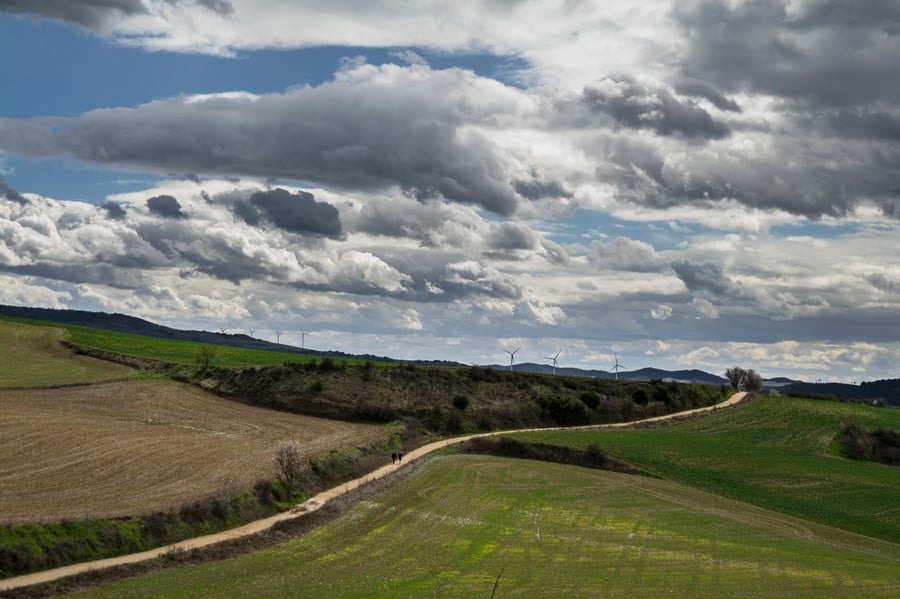
The French Way – Camino de Santiago Photos
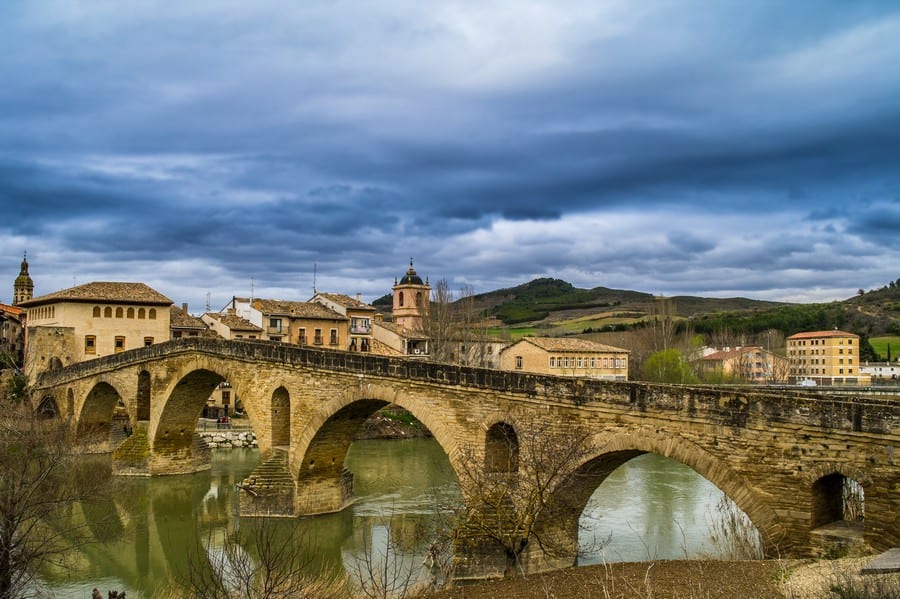
Puenta La Reina in the evening
Crossing Puente La Reina on the Camino de Santiago
After leaving the busy streets of Pamplona, the quiet village of Puente La Reina felt like a reward. It was the first place I stayed overnight after several long days of walking the Camino de Santiago, and it quickly became one of the most memorable stops of my journey.
A Bridge That Defines the Camino
The bridge of Puente La Reina is one of the most striking landmarks along the Camino de Santiago. Built in the 11th century to help pilgrims cross the Arga River, its graceful stone arches stretch across the water like an open invitation to continue onward. Standing on the bridge, I could almost picture centuries of travelers before me, carrying the same determination and hope that every modern pilgrim brings.
A Peaceful Pause After Pamplona
After the crowds and energy of Pamplona, Puente La Reina offered calm. The narrow streets, the soft sound of the river below, and the sight of the bridge glowing in the evening light created a feeling of stillness that I hadn’t realized I needed. Resting there, surrounded by history and quiet beauty, reminded me that the Camino de Santiago is as much about slowing down as it is about pressing forward.
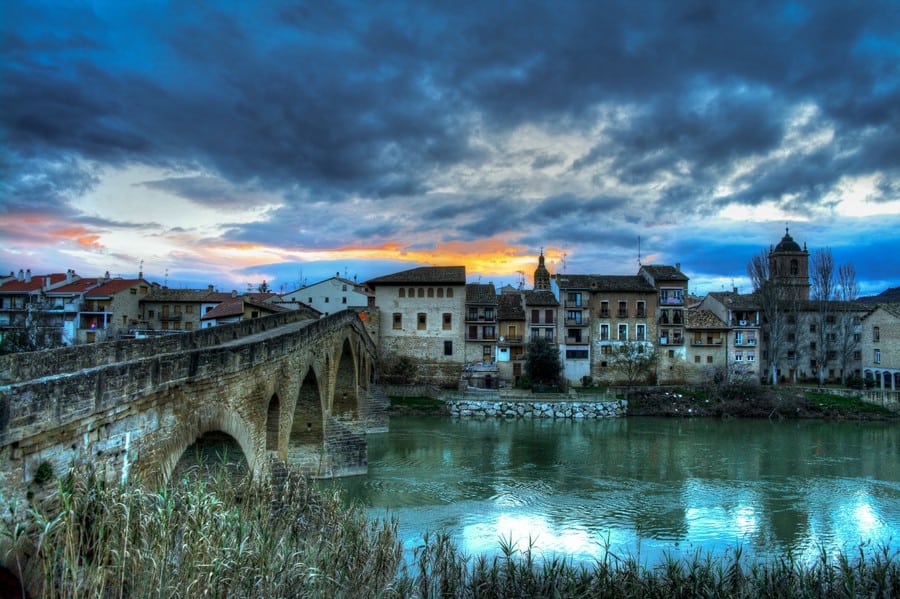
Puenta la Reina Bridge at sunrise
Most mornings, I was up and walking before the sun began to sprinkle across the horizon.
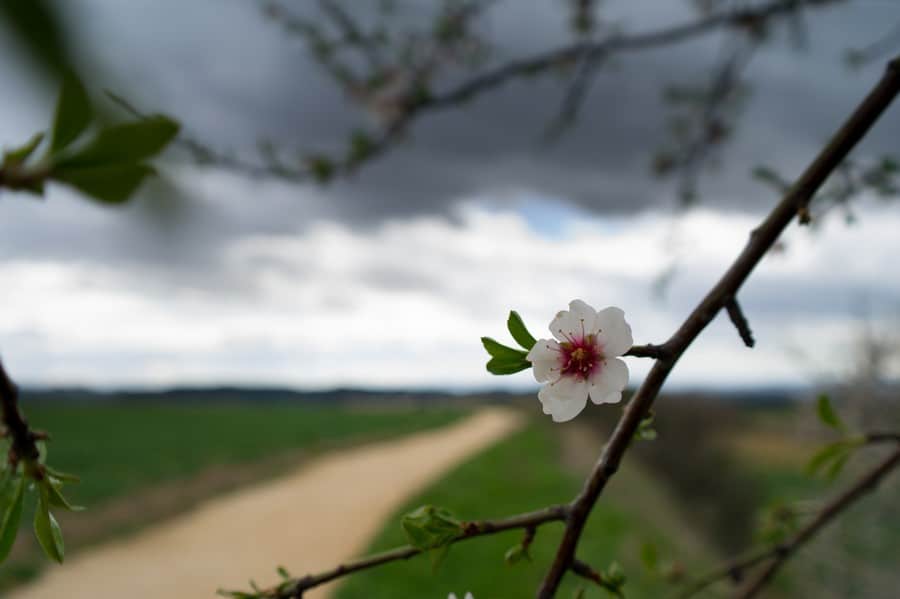
Spring flowers on the Camino de Santiago

Pilgrims approaching Cirauqui, Spain
Climbing the Hilltop Villages Along the Camino de Santiago
One of the first things I noticed while walking the Camino de Santiago was that every village and town seemed to sit on top of a hill. From a distance, they looked picture-perfect — stone buildings clustered together, church towers rising above rolling fields, and winding paths leading upward through olive groves and vineyards. It was easy to admire the view until I realized what those hills meant for my legs.
The Beauty and the Burn
Each climb brought a mix of admiration and fatigue. The hills gave incredible panoramic views of the Spanish countryside, but they also tested my endurance. Just when I thought I had reached the top, another incline waited around the corner. The uphill paths were a reminder that the Camino de Santiago isn’t just a journey of distance but one of determination.
Finding Rhythm in the Ascent
Despite the challenge, there was something rewarding about each climb. The quiet rhythm of my footsteps on the cobblestones, the brief pauses to catch my breath, and the promise of a village café or shaded plaza at the top made the effort worth it. Every uphill stretch along the Camino de Santiago carried its own small victory — proof that persistence, not speed, defines a true pilgrim.
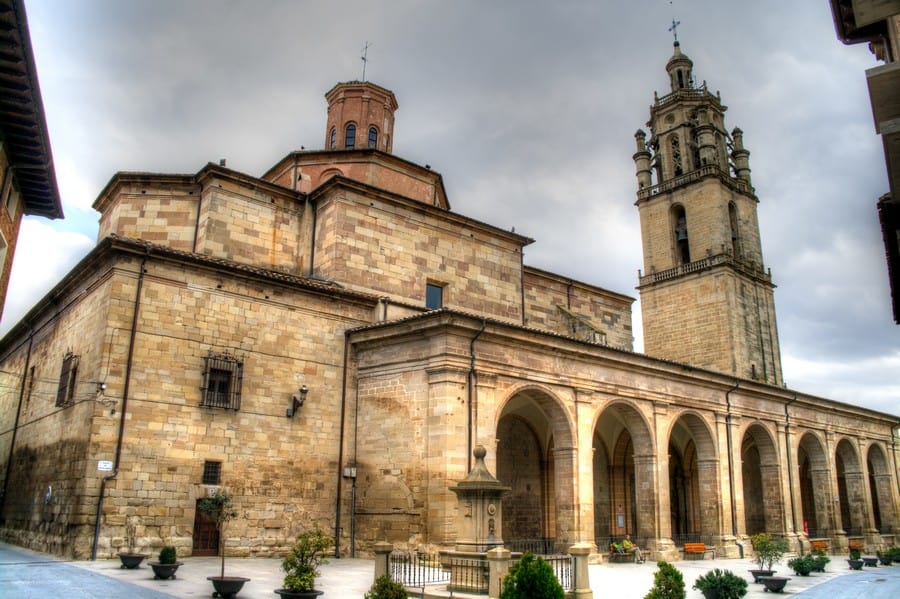
Church of Santa Maria in Los Arcos
While only about 20 pilgrims were walking each section every day, it wasn’t uncommon for you to encounter them all. The people I met along the Camino de Santiago were some of the most inspiring and remarkable people I have ever spoken to. They are the ones that make the pilgrimage so unique.
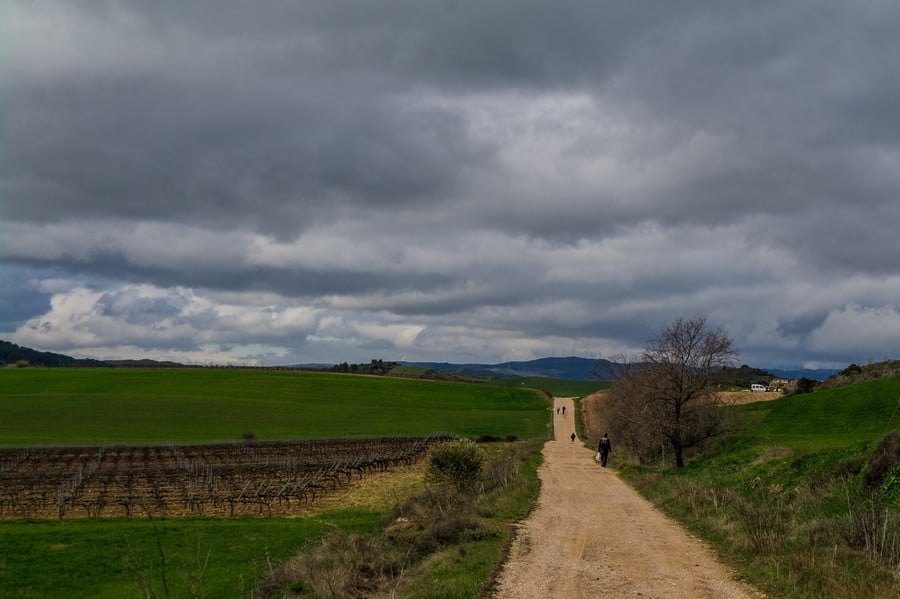
The endless French Way
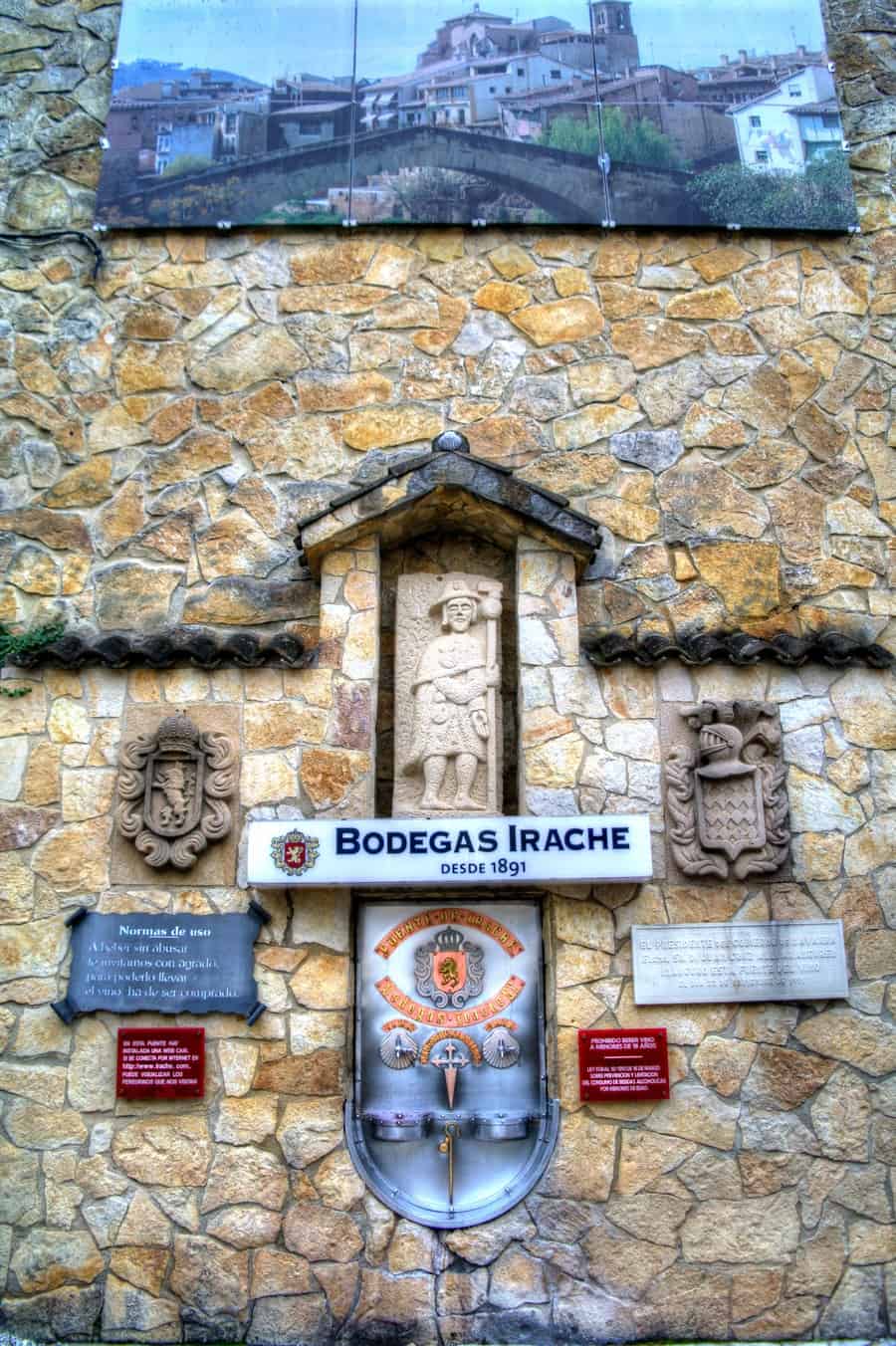
The free-flowing Irache Wine Fountain or “Fuente del Vino.”
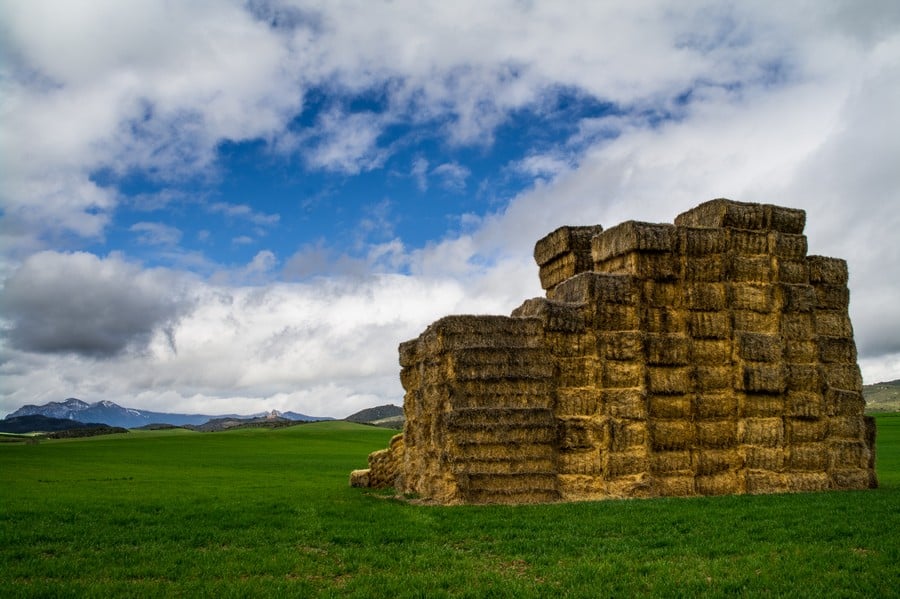
Hay bales along the French Way
Every village had at least one ancient church, and it wasn’t uncommon to find them dotting the landscape in remote locations either.
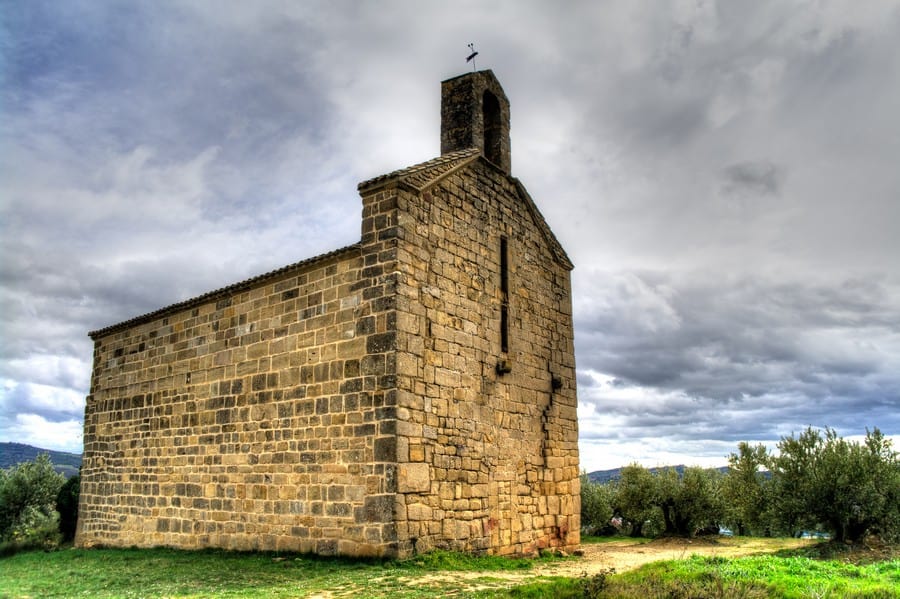
Ermita de San Miguel
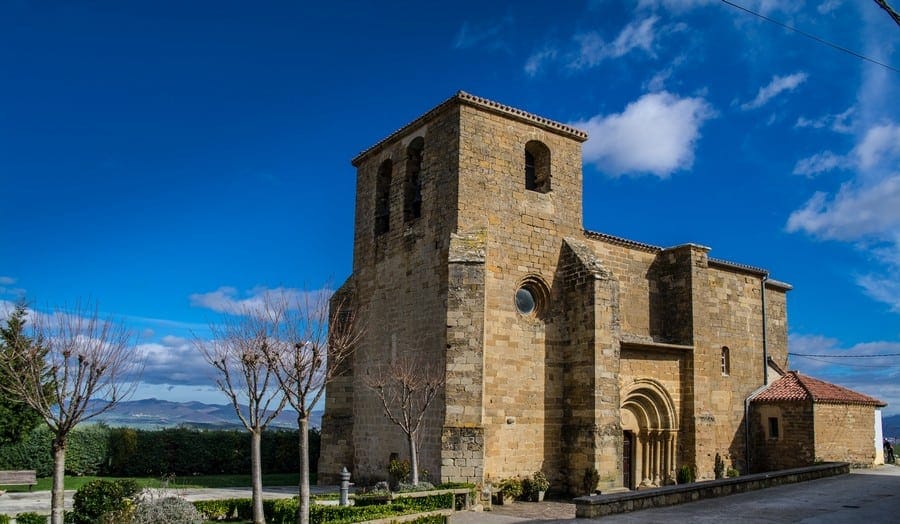
Iglesia de San Andrés de Zariquiegui Church
I have traveled through Spain, including cycling in Costa Brava and surfing in San Sebastian with both independent planning and a vacation planner. But having the opportunity to walk at my own pace through some of the most beautiful scenery in Spain on the Camino de Santiago has so far topped them all.
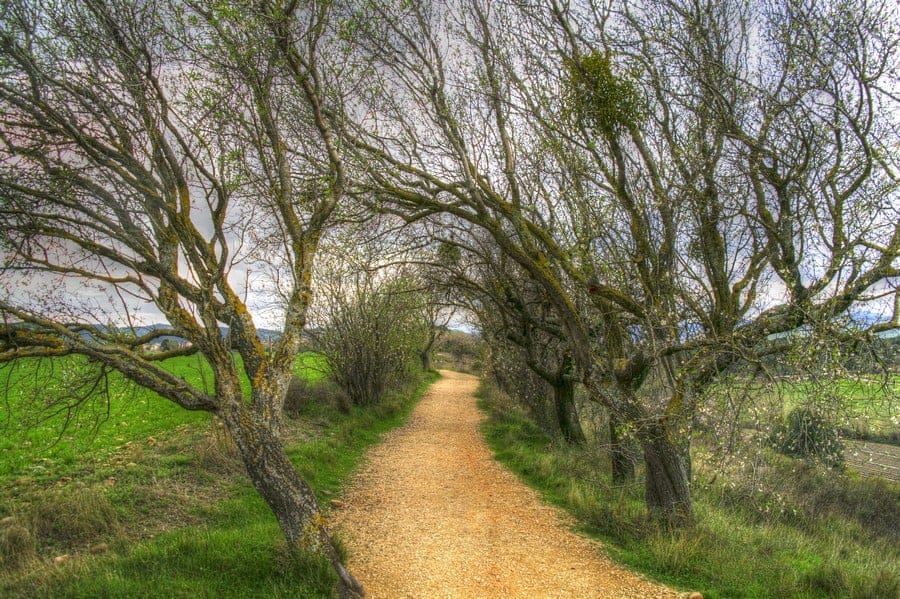
Natural arches on the Camino de Santiago

